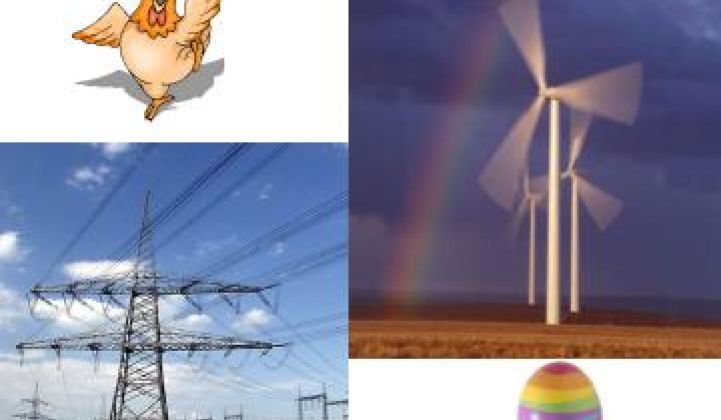Texans had been building wind farms on their wind-rich rural plains so fast they were running out of transmission capacity by 2005, though the state’s fast-growing urban areas were still hungry for new sources of renewable power. Transmission builders were reluctant to develop new infrastructure where wind projects had not yet been built and wind developers were reluctant to site projects where there was no transmission. Texans called it the “chicken and egg thing” and they decided not to let it stop them.
The legislature mandated the Public Utility Commission of Texas (PUCT) to identify Competitive Renewable Energy Zones (CREZs) where there were readily exploitable renewable energy assets, especially wind power, without adequate transmission.
The PUCT set the budget for developing transmission in the five identified zones at $4.93 billion and awarded nine priority CREZ projects to the state’s two primary utilities, Oncor Electric Delivery LLC (Oncor) and LCRA Transmission Services Corporation (LCRA TSC), as well as more than twenty more projects to other utilities. The PUCT also defined each project, subject to local needs, as two 345-kilovolt AC lines, twenty substations, six switches and five terminals. According to the TPUC, the completed CREZ undertaking will be delivering 18,456 megawatts of wind energy-generated electricity to Texas ratepayers by the end of 2013.
Catherine Cuellar, spokeswoman for Oncor, which had the most miles of new projects (about 850) awarded by the PUCT, said Oncor’s CREZ projects are going well. “All of our priority projects were approved and are moving forward,” Cuellar said.
The priority projects, Cuellar said, are to alleviate grid congestion and bring existing Texas wind farms “up to their full capacity.” Subsequent transmission projects will facilitate new wind development. “This project is like a farm-to-market road, getting the wind-generated electricity from facilities in the Panhandle and West Texas in the CREZ to customers statewide.”
Terry Hadley, spokesman for the PUCT, said the CREZ plan is proceeding “sure and steady,” adding, “For the most part the schedule is on track.” Hadley also said a similar plan to advance solar is in the works.
The CREZ concept is moving Texas, Cuellar said, to “the forefront of the global renewable energy economy. Texas is currently leading the United States in the availability of wind-generated electricity, and when the CREZ lines are completed the state will be one of the top world wind-electric markets.”
Cuellar called Oncor’s work on smart meters and within the CREZ plan “the foundational infrastructure to pave the way for electric cars,” because “wind power can charge those vehicles at night and smart meters can help customers determine when to charge, as well as helping them take advantage of time-of-use pricing.”
With the implementation of the CREZ plan, the state’s legislature delimited the review process for new transmission proposals, from “up to a year” down to 180 days. During the review period, both Texas and Oncor still encourage extensive and vigorous public participation. “The more the public gets involved,” Cuellar said, “the fairer the process will be.”
Oncor won “the largest portion” of the CREZ lines, Cuellar said, “because of our hundred-year history as a Texas company building transmission lines, our relationships with vendors, suppliers and contractors,” as well as pre-existing evidence “that we could build these lines on schedule and on budget." Plus, it doesn't hurt that the company has "a history of dealing fairly with the public.”
Since they began, Cuellar said, there have been “more meetings in a shorter time frame” to inform landowners of the benefits of new transmission, and overall, she added, “We have never been working on more new transmission at once.” Though “the big picture is that all new projects will be in service by 2013,” Cuellar said, some new lines are already in service “in the cases where we were adding transmission capacity within our existing easements and just constructing new towers and more wires.”
Texans will, Cuellar pointed out, reap huge economic benefits. “New job creation in the development and support of these lines make it worth our attention.” Oncor has located much of its supply chain in-state, Cuellar said. “That’s a big economic opportunity.”
The CREZ plan trades on its claim to be about transmission for wind but, in fact, the lines will carry whatever electrons are loaded on. Oncor is not a power generator, but will recover its costs from electric rates whether the wires carry electrons generated by wind, coal, nuclear or natural gas. “The CREZ projects,” Cuellar acknowledged, “are both delivering wind power and alleviating congestion.”
Cuellar noted how difficult it has sometimes been to convince the public to allow the new transmission necessary to deliver the electricity it demands. But, she insisted, “It’s a challenge and a success story because the process is fair and provides economic and environmental benefits to all Texans.”
Improved community outreach promises to be vitally important in Oncor’s next big undertaking. “This is but one of the public interactions that we have with more than 400 cities that we serve,” Cuellar said. “The new transmission and smart grid will shake hands with smart meters at more than three million points of delivery throughout our system.” It is, she added, “what makes this time so exciting for us.”



